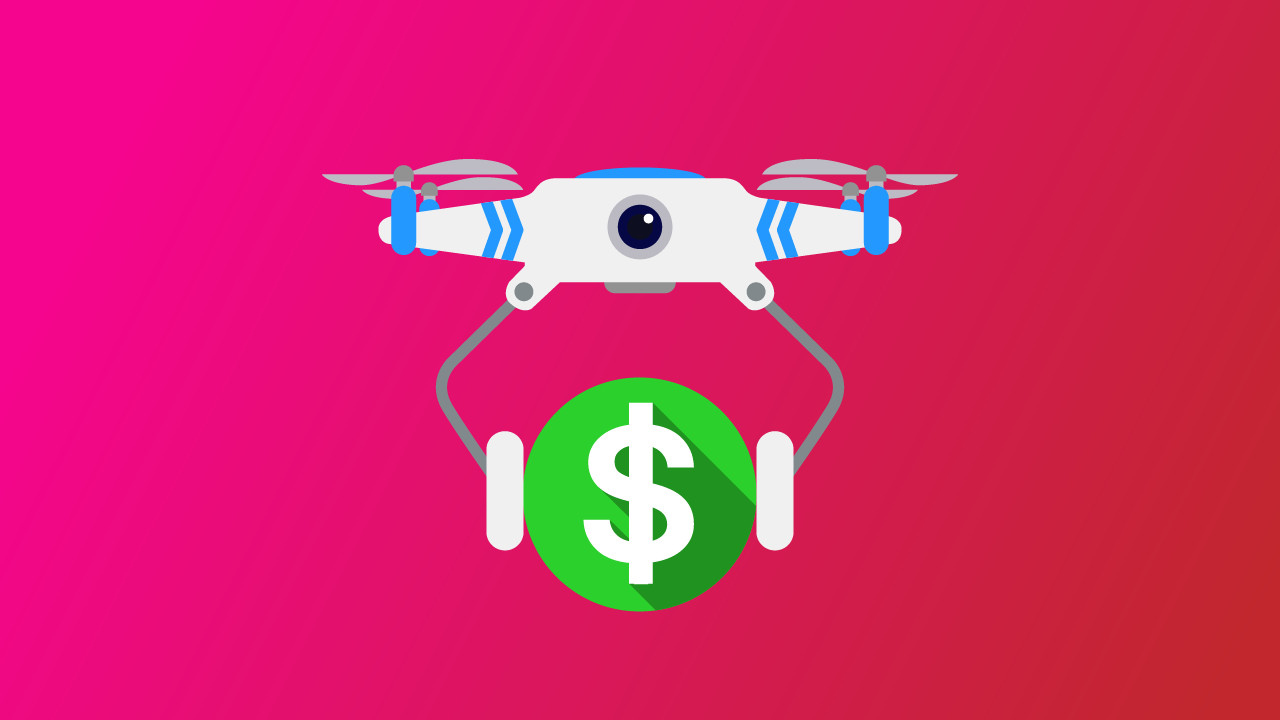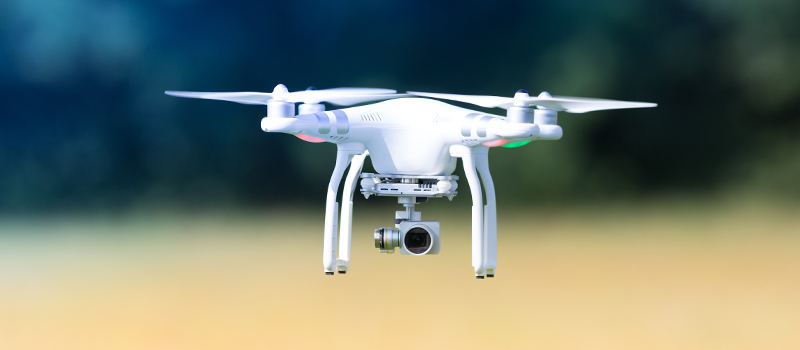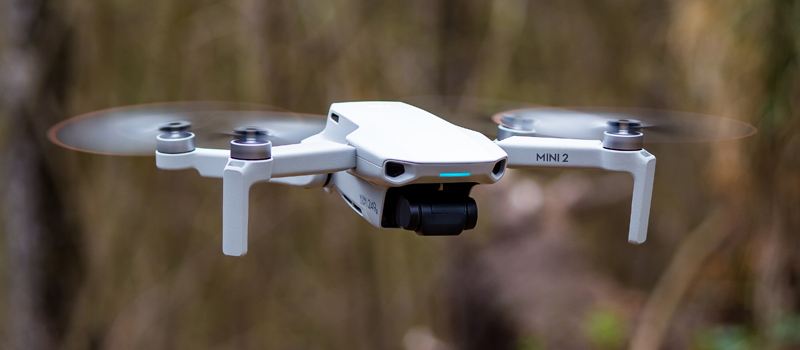-
Key Takeaways
-
The Growing Drone Industry in 2025
- Technological Innovations Driving the Industry
-
Top 15 Drone Business Ideas for 2025
- 1. Aerial Photography and Videography
- 2. Real Estate Marketing Services
- 3. Drone Mapping and Surveying
- 4. Agricultural Monitoring and Crop Analysis
- 5. Infrastructure Inspection Services
- 6. Roof Inspection Services
- 7. Construction Site Monitoring
- 8. Drone Delivery Services
- 9. Search and Rescue Operations
- 10. Drone Pilot Training and Education
- 11. Drone Rental Business
- 12. Drone Repair and Maintenance Services
- 13. Drone-Based Security Surveillance
- 14. Environmental Monitoring
- 15. Wildlife Conservation and Research
-
Understanding Drone Regulations and Certifications
-
Tips for Starting a Successful Drone Business in 2025
- Choosing the Right Idea: Research & Development
- Aligning with Your Skills and Interests
- Drone News Update
- Evaluating Startup Costs and ROI
- Investing in the Right Equipment
- Developing Marketing and Networking Strategies
- Embracing Continuous Learning and Innovation
-
Conclusion
With the drone market projected to exceed $40 billion by 2030, now is the time to explore how to cash in on the market growth. We’re here to help you determine if starting a drone business is right for you. Let’s take a look at the top 15 drone businesses offering lucrative potential in 2025 and beyond.
Key Takeaways
- There is new potential for drone industries with the FAA’s expansion of BVLOS.
- Drone technology is advancing rapidly with AI automations and cutting-edge sensors.
- Explore creative drone business ideas like aerial videography and surveying.
- There are diverse inspection and monitoring needs in industries like agriculture, industry, and emergency services.
- Gain insight and key tips on how to start your own drone business!
The Growing Drone Industry in 2025
The drone industry is witnessing rapid expansion across several industries. What’s driving this growth?
Well, it’s a mix of rapidly advancing technology with more favorable regulatory frameworks. AI is becoming more widely accessible and cheaper to integrate into UAS designs.
Drone operations are also garnering regulatory support. For example, the FAA approved drone delivery beyond visual line of sight (BVLOS).
Amazon Prime Air received BVLOS approval for its delivery drone fleet in 2024 and is now expanding drone delivery services.
To address the increasing BLVOS traffic in the sky, the FAA is currently developing the Unmanned Aircraft System Traffic Management to establish a regulatory framework for managing flight planning, surveillance, and operations.
Technological Innovations Driving the Industry
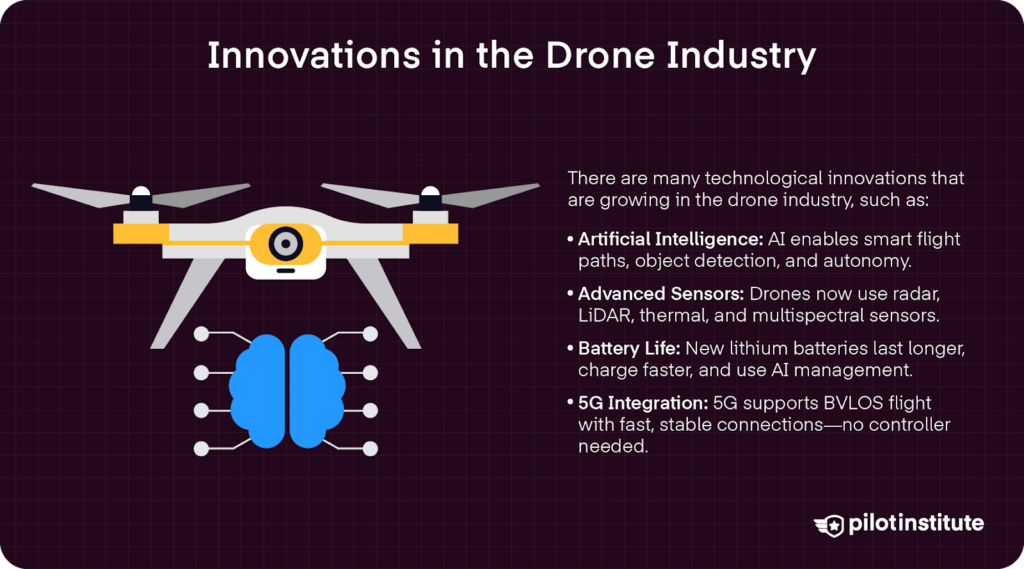
Artificial Intelligence
Innovative advancements in AI have empowered a new wave of drones capable of autonomous flight and intelligent decision-making.
Machine learning (ML) utilizes complex algorithms to learn from massive data inputs, allowing drones to make predictions and decisions that impact their ability to detect objects and generate flight paths.
Even more impressive, advanced deep learning (DL) AI algorithms have increased the efficiency of “real-time object detection and recognition through the use of massive data processing techniques for dynamic path optimization.”
Advanced Sensors
All of this data feeding into AI learning models comes from increasingly powerful and sophisticated sensors.
The implementation of micro-doppler signatures in radar systems on UAVs has greatly improved efficiency, up to 98% when using multi-statis radar systems.
Today’s LiDAR sensors are getting more affordable and in a smaller form factor, making them more accessible. Thermal imaging sensors now offer much higher resolutions with improved image processing.
Multispectral sensors for specialized applications capture data at specific wavelengths on the electromagnetic spectrum, analyzing vegetation health, water quality, and soil composition.
Improved Battery Life
Drone pilots have been thrilled to also see major improvements in battery systems, offering far greater ranges for today’s UAVs. Advances in lithium-ion technologies offer faster charging, longer ranges, and higher energy density.
AI is even being used in innovative battery management systems (BMS) to make smart batteries even smarter.
5G Integration
UAVs are more connected than ever before, thanks to an increasing number of models including 5G integration.
5G capabilities empower modern UAVs to perform more efficiently in BVLOS scenarios. Skydrone’s MK1, for example, uses a 4G/5G cellular connection, so pilots do not need a clunky radio controller.
Top 15 Drone Business Ideas for 2025
Here are the top 15 ideas, and we’ll break each one of these down:
- Aerial Photography and Videography
- Real Estate Marketing Services
- Drone Mapping and Surveying
- Agricultural Monitoring and Crop Analysis
- Infrastructure Inspection Services
- Roof Inspection Services
- Construction Site Monitoring
- Drone Delivery Services
- Search and Rescue Operations
- Drone Pilot Training and Education
- Drone Rental Business
- Drone Repair and Maintenance Services
- Drone-Based Security Surveillance
- Environmental Monitoring
- Wildlife Conservation and Research
1. Aerial Photography and Videography
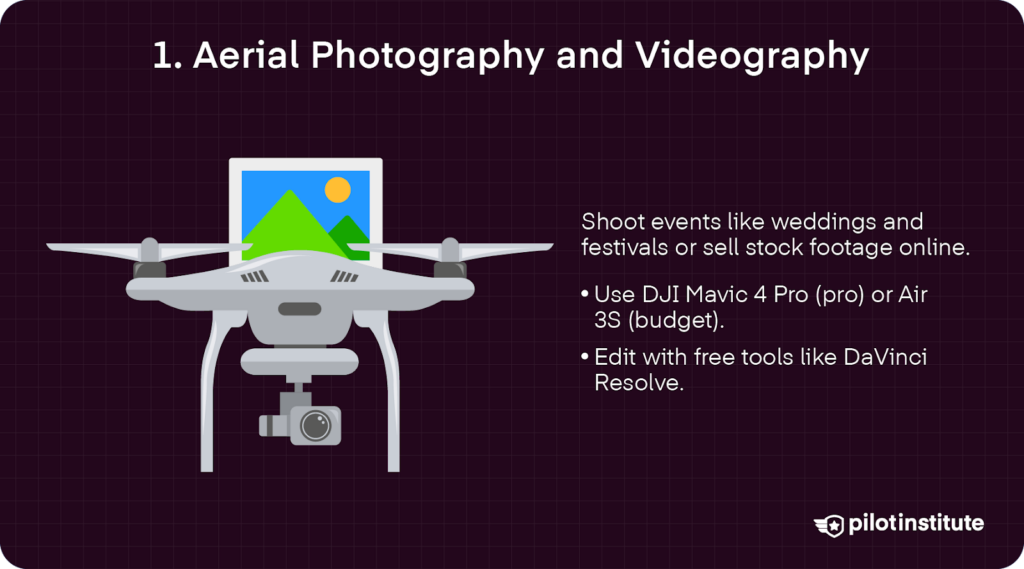
Aerial photography and videography are some of the most accessible drone industries thanks to affordable, high-quality UAVs.
Filmmakers, event planners, and venues often hire drone pilots for weddings, concerts, and festivals. And guess what? You can earn passive income by selling stock footage on platforms like Adobe Stock and Blackbox.
For gear, the DJI Mavic 4 Pro offers top-tier quality, while the DJI Air 3S is a more budget-friendly option.
Learn basic editing and color grading using tools like Adobe Lightroom and DaVinci Resolve (free version available) to make your footage stand out.
2. Real Estate Marketing Services
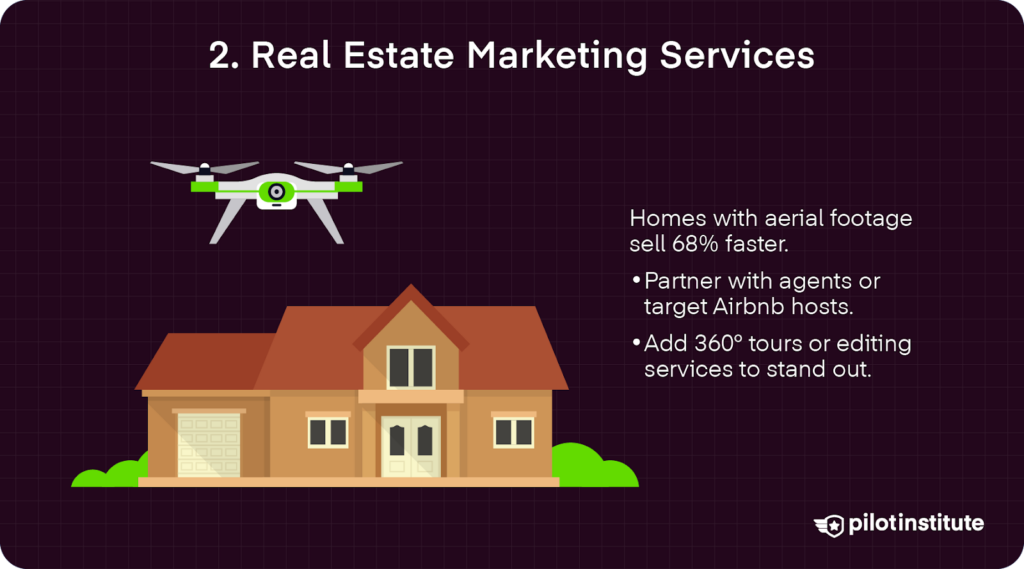
Aerial images and video tours make homes “68% more likely to sell,” according to the National Association of Realtors.
Aerial entrepreneurs can partner with local real estate agents or property developers to showcase properties from a bird’s-eye view. They can also expand into seeking out vacation homeowners to grab attention on crowded sites like Airbnb.
Combining ground photography or 360-degree virtual tours can strengthen your competitive edge.. For those with editing experience, offering post-production services helps make footage pop.
3. Drone Mapping and Surveying
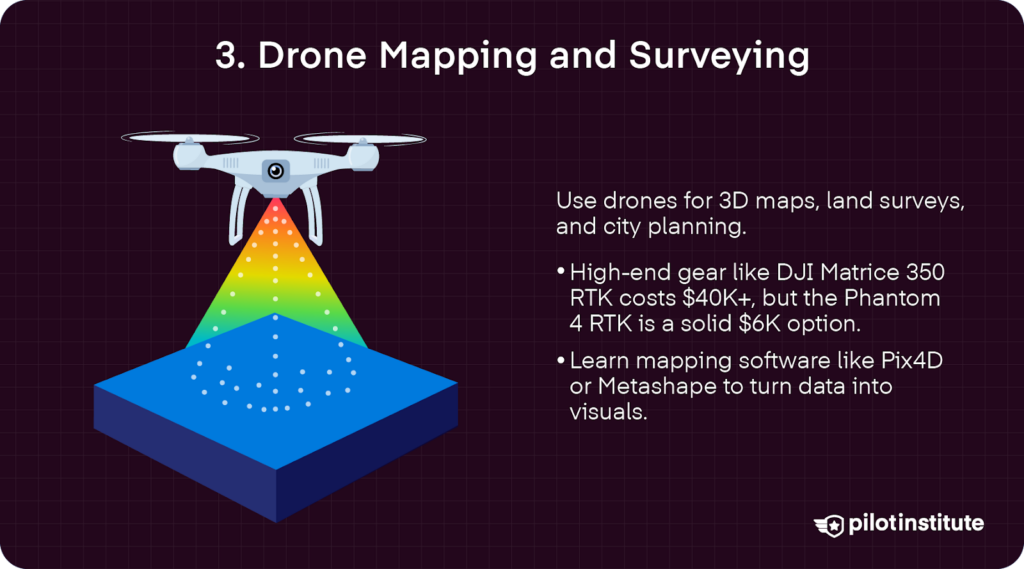
With all the new, exciting sensor advancements, complex UAVs shine in topographic surveys, 3D mapping, and land assessments.
Pilots can bid to work with urban planners and local governments for city development projects, or with mining firms to get into tight spaces that humans can’t.
However, the types of UAVs needed can get quite pricey. For example, the DJI Matrice 350 RTK with Zenmuse L2 LiDAR can set you back upwards of $40,000.
Fortunately, the incredibly compact but still powerful DJI Phantom 4 RTK is more affordable, at $6,000.
It is also important to get familiar with photogrammetry and mapping software like Pix4D and Agisoft Metashape to be able to manipulate all that beautiful data into stunning visual maps.
4. Agricultural Monitoring and Crop Analysis
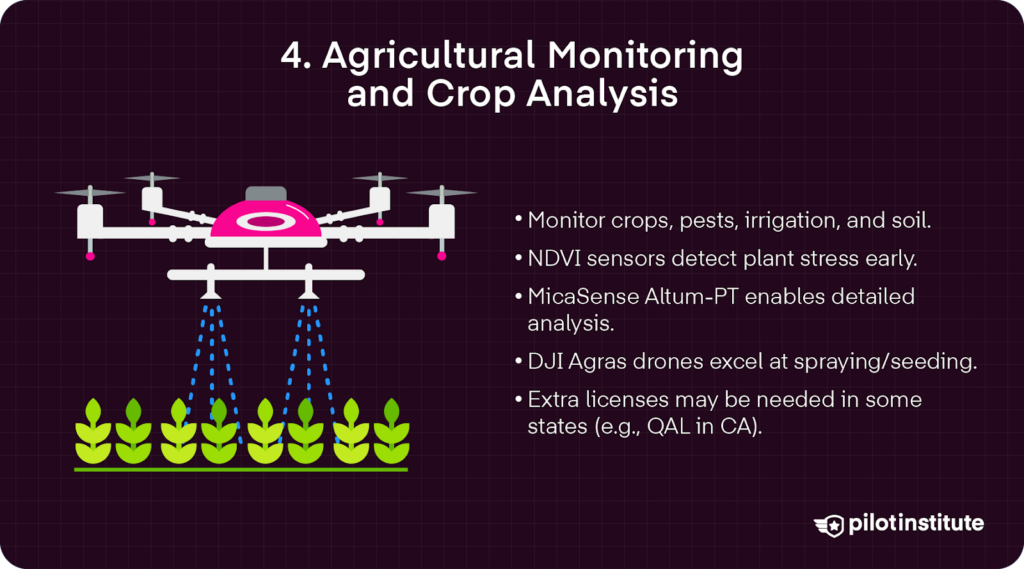
The agricultural industry is one of the top industries for commercial drone operations, making up 26% of the market share.
Drones monitor crop health, assess irrigation needs, seed large areas, detect pests, and spray pesticides over large farming surface areas. Individual farmers, farming collectives, and massive commercial farms are seeking precision agricultural solutions.
NDVI (Normalized Difference Vegetation Index) sensors help monitor crop health using high-resolution images to identify diseases, stress, or nutrient deficiencies before they threaten the crop yield.
Pilots can also outfit their UAVs with the MicaSense Altum-PT, a camera that offers multispectral capabilities for precise crop monitoring and soil analysis.
For both spraying and seeding operations, the models in the DJI Agras series are a great investment, although they come with high price tags.
Depending on the state, pilots may need additional licensing, such as the Qualified Applicator License (QAL) in California, to handle certain chemicals.
5. Infrastructure Inspection Services
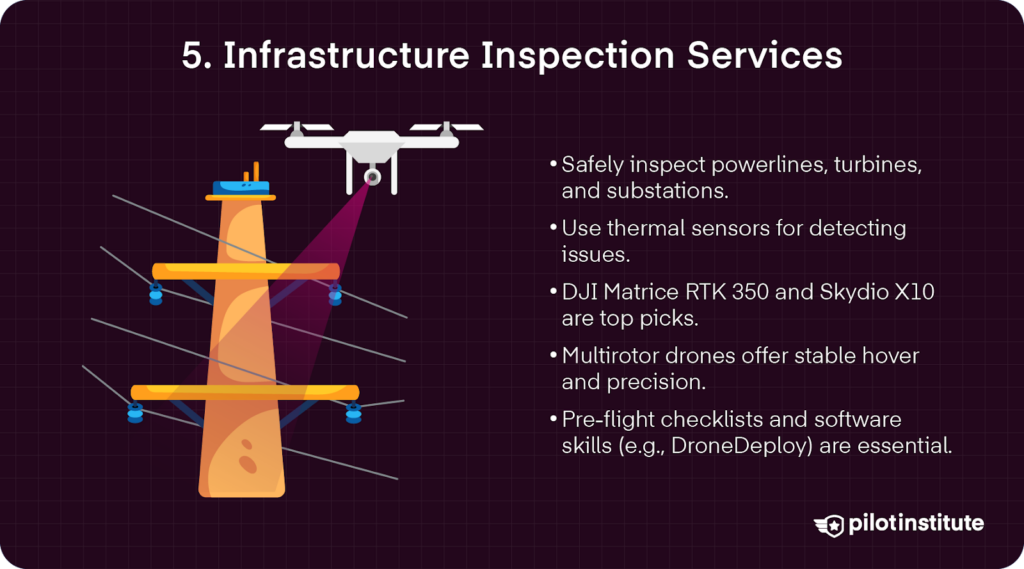
Drones can inspect critical infrastructure safely and efficiently, without putting human workers in harm’s way.
Drones are capable of getting up close and personal with powerlines and other tall structures, like wind turbines. Experienced pilots can also offer inspection services for facilities like substations with infrared imaging sensors.
The best options here are multirotor drones that offer incredible stability and hovering capabilities. For example, the DJI Matrice RTK 350 features centimeter-level accuracy and impressive data processing speeds.
The Skydio X10 is a DJI alternative, offering impressive autonomous flight capabilities and an innovative modular design.
Pilots should build a robust and comprehensive pre-flight inspection checklist.
Familiarity with specialized sensors, like thermal cameras, is key to interpreting complex data. Experience with software like Dronedeploy is also often required for many contract jobs in this field.
6. Roof Inspection Services
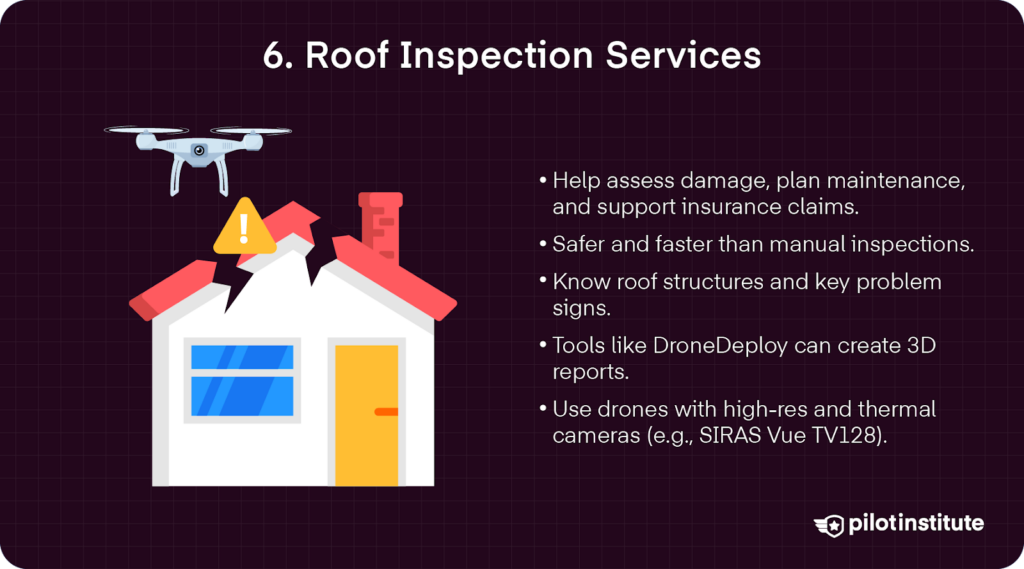
With the average roof replacement cost reported at $9,500 on NerdWallet, buyers want to make sure they are not setting themselves up for unexpected roof costs.
Pilots are often contracted to conduct drone roof inspections for damage assessment, maintenance planning, and insurance claims. An extra eye in the sky can ensure safe and efficient inspections without the risks associated with manual climbing.
A thorough understanding of roof structures and awareness of common issues to look for is key here. It also helps to be able to generate comprehensive inspection reports, such as 3D models created using software tools like DroneDeploy.
A high-resolution camera and a UAV model with interchangeable payloads empower you to scale your business and seek more technical inspection jobs down the road.
The SIRAS Vue TV128 offers a quick-connect system with two interchangeable sensor payloads, including a high-resolution camera and a radiometric thermal camera.
7. Construction Site Monitoring

Construction companies are also always looking for better inspection options to help monitor project progress, site logistics, and compliance. Pilots offer 3D modeling and site mapping, hyperlapse footage of site progress, and safety inspections.
Project managers need regular updates to satisfy nervous investors. Plus, all stakeholders benefit when issues are identified early and addressed promptly, reducing the impact of larger unexpected costs.
Pilots can triple dip here, using a similar UAV model to offer industrial, residential, and construction inspections.
8. Drone Delivery Services
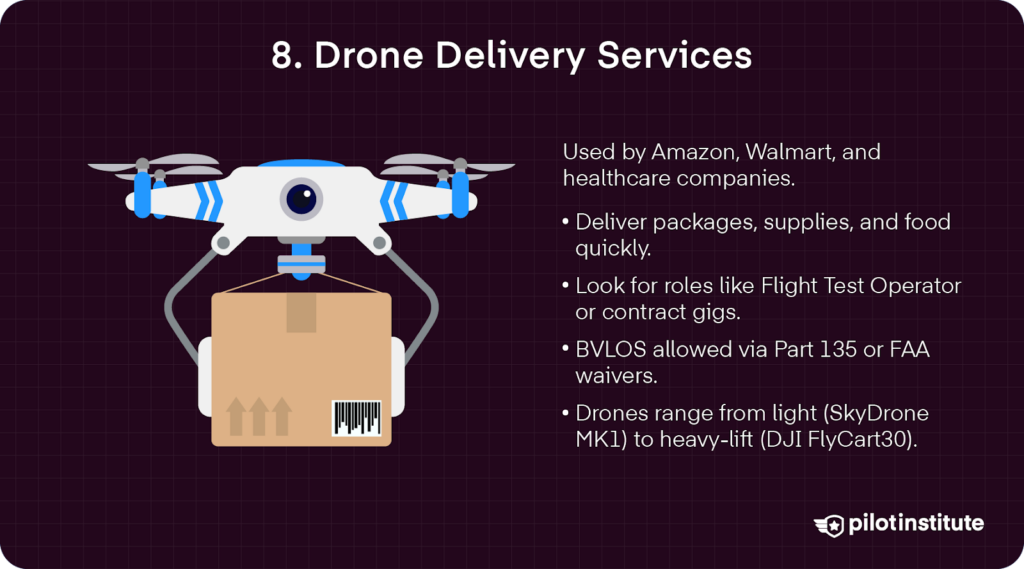
Amazon’s Prime Air and Walmart’s partnership with Wing and Zipline are just two examples of the booming potential in drone delivery services offering speedy and efficient package, supply, and even food deliveries.
Amazon Prime Air, for example, is currently hiring for roles like Flight Test Operator.
You can also look for contract delivery work with healthcare companies for rapid transport of medical supplies and products, as well as with restaurants aiming to offer lightning-fast delivery options.
Part 135 Certification is one pathway for BVLOS operations. The FAA also grants authority for BLVOS through waivers to Part 107 rules and under other special authorities, as seen in 49 U.S.C. § 44807.
Good delivery models range significantly in terms of payload capacity. For example, SkyDrone’s MK1 is equipped with 4G/5G antennas and approved for BVLOS operations. While it can only carry payloads of 2.2 lbs (1 kg), it has a decent range at 45 minutes of flight time.
For those big deliveries, there is the DJ FlyCart30, which has a cargo and winch mode for easy drop off for payloads up to 66 lbs (30 kg).
9. Search and Rescue Operations
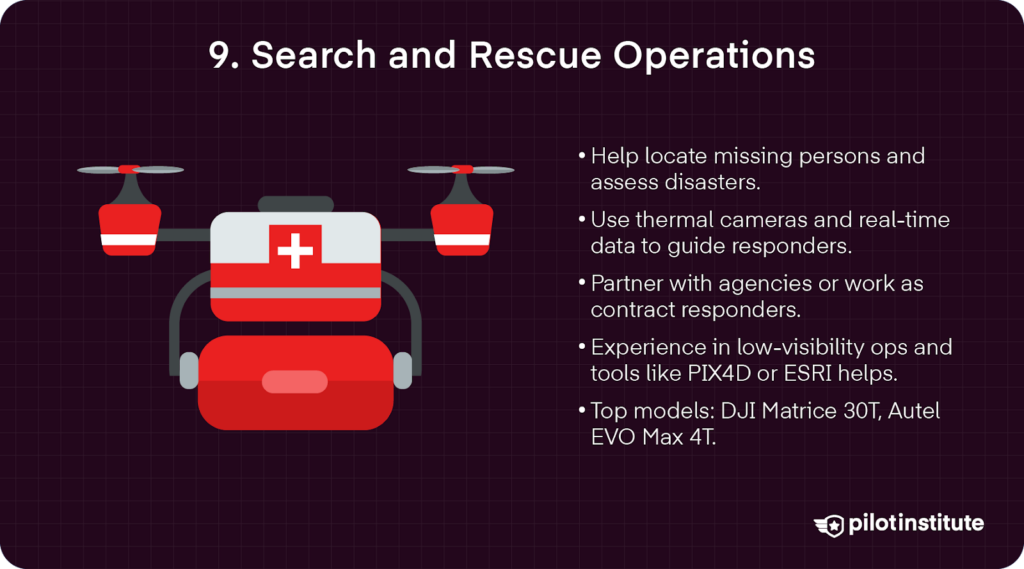
Drones are also badly needed to assist emergency services in locating missing persons, conducting disaster assessment, and delivering aid.
UAVs use high-resolution and thermal cameras to spot survivors in low-visibility environments. Real-time data also helps shape decision-making, without putting first responders in danger.
Pilots looking to enter this field can partner with local government and public service agencies to help draft and develop a program to integrate UAVs into search and rescue operations. They can also act as contract emergency responders during natural disasters and other significant events.
Pilots must have experience working in low-visibility scenarios. Also, experience with data processing and interpretation software, like PIX4D Pro and ESRI SiteScan is often required.
Luckily, Pilot Institute has a great Drone Search and Rescue Essentials course.
Top drone models for search and rescue operations include the DJI Matrice 30T. Its IP55 rating makes it well suited for rugged environments. A DJI alternative would be the Autel EVO Max 4T, outfitted with impressive thermal imaging cameras and a laser range finder sensor.
10. Drone Pilot Training and Education

Turn your drone knowledge into cash by offering workshops, training courses, and certification preparation for aspiring drone pilots.
Individual pilots navigating the Part 107 Certification test or learning how to apply for LAANC authorization are always looking for trusted guidance. You can expand this model to suit the training needs of corporate teams.
Educational institutions like colleges and high schools also often contract out for pilots to teach their budding drone programs. You can even partner with top online drone schools, like us here at Pilot Institute, where we offer a wide range of courses available for drone pilots.
11. Drone Rental Business
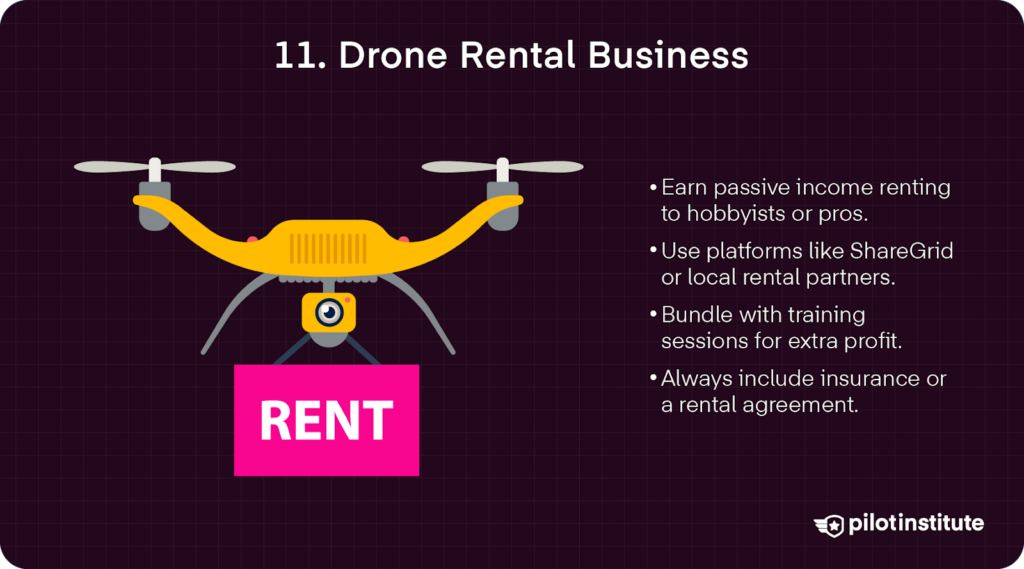
If you haven’t flown your drone recently, put it to work anyway. Renting UAVs and related equipment to hobbyists and professionals is a great source of passive income.
Filmmakers or event organizers, for example, may want aerial coverage of a specific moment without equipment investments, and happen to have a Part 107-certified pilot on the crew.
There are also online rental marketplaces that have willing clients. Renting your drone out on sites like ShareGrid. You can also search your local area to partner up with more location-specific rental companies.
This can be layered with offering drone training and education programs. Offer package deals with training sessions to double-dip on drone profit potential.
Just make sure that whatever company you choose to work with offers insurance protection, or if you are renting on your own, implement a rental agreement covering liability and damages.
12. Drone Repair and Maintenance Services
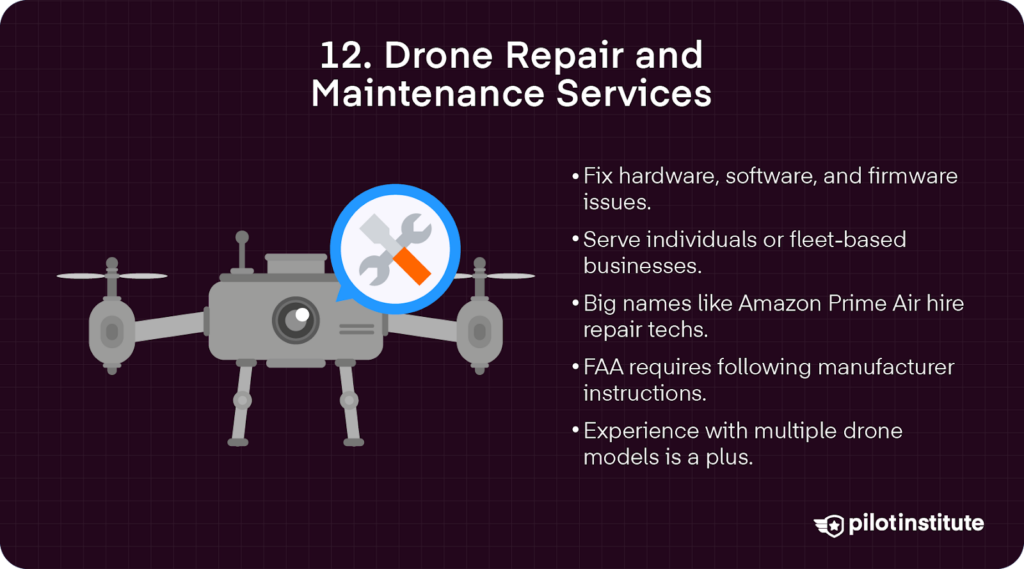
With all the extra UAVs in the air, tinkerers with experience disassembling and repairing various UAV components are in high demand.
Potential clients range from individual operators experiencing technical issues to larger businesses that need regular maintenance for their growing fleets. Repair services can also include handling buggy firmware updates and software troubleshooting.
There are opportunities to work with major retailers as they take their logistics to the skies. Amazon Prime Air, for example, has several Repair Technician openings in states across the country.
The FAA’s guidelines for drone repairs highlight the importance of keeping in compliance with the manufacturer’s instructions, as published in the manual. So, experience with different drone models is a plus.
13. Drone-Based Security Surveillance
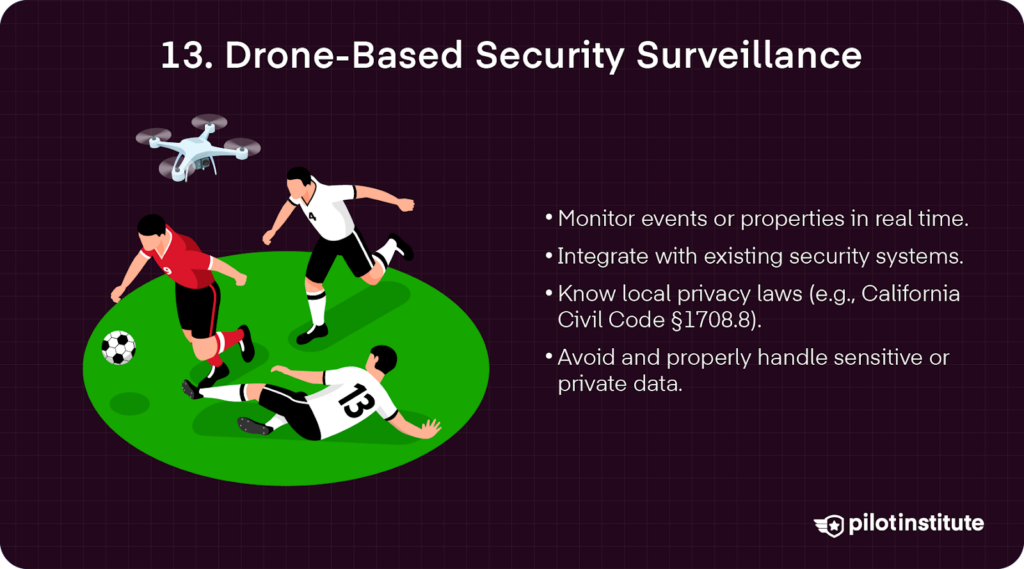
Organizers managing large crowds or property owners of commercial or industrial sites often seek to add drones to their security arsenal. Pilots can offer on-call, real-time monitoring and threat detection to integrate with existing security systems.
Just make sure you are caught up on the nuanced privacy laws in the area you will be working.
In California, for example, Section 1708.8 of the Civil Code prohibits drones from capturing “any type of visual image, sound recording, or other physical impression” of an individual “engaging in private, personal, or familial activity.”
Even if such content is caught unintentionally, as a peripheral capture during other security operations, pilots can be liable for invasion of privacy. Proper handling of sensitive data is also important.
14. Environmental Monitoring
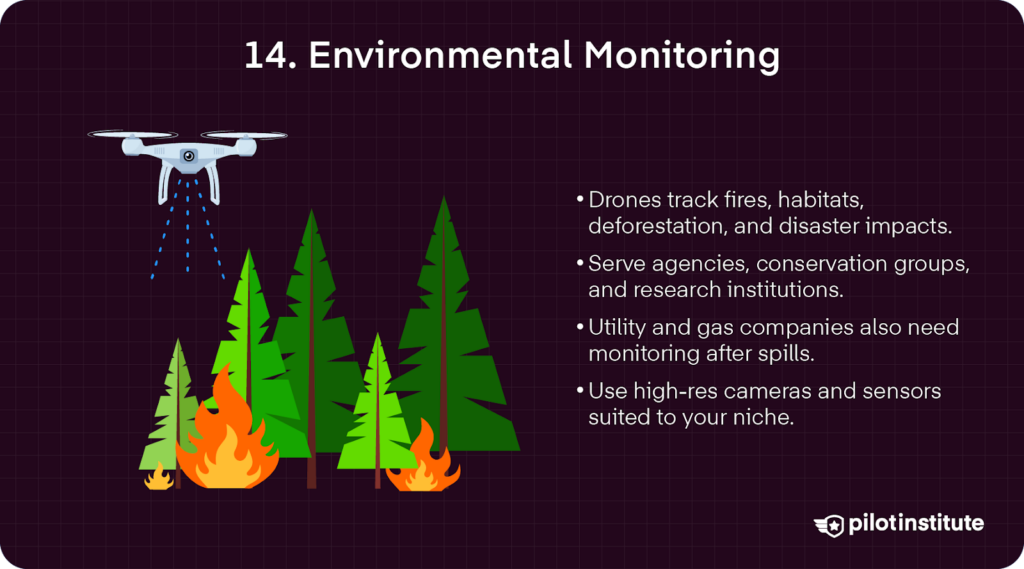
With wildfire risks increasing, drones play an important role in monitoring landscapes for fires, evaluating wildlife habitats, tracking deforestation, and assessing environmental impacts when natural disasters do occur.
Top customers in this niche would include government environmental agencies conducting research, conservation groups protecting ecosystems, and research institutions studying climate change.
Even utility and gas companies seek out such services, especially in the event of a spill or other incident that requires organizing environmental monitoring and clean-up responses.
Investing in a camera system with high-resolution and key sensor technologies that fit your niche market is key to making sure you can offer the most efficient monitoring services.
15. Wildlife Conservation and Research

Finally, drone pilots can niche down this idea even further by focusing on wildlife-specific monitoring services.
Pilots can assist in tracking animal populations, studying habitats, and monitoring migration patterns to empower wildlife conservation and nonprofit organizations in their conservation and research efforts. They can also contract for government agencies, like the National Park Service or the Department of the Interior.
Pilots need to be sensitive to the unique demands of working near wildlife, as getting too close can harass and endanger delicate species.
The U.S. Forest Service recommends launching “more than 100 meters (328 feet) from wildlife” and not to “approach animals or birds vertically with the UAS.” From an ethical standpoint, minimizing any disturbance to wildlife is key.
Understanding Drone Regulations and Certifications
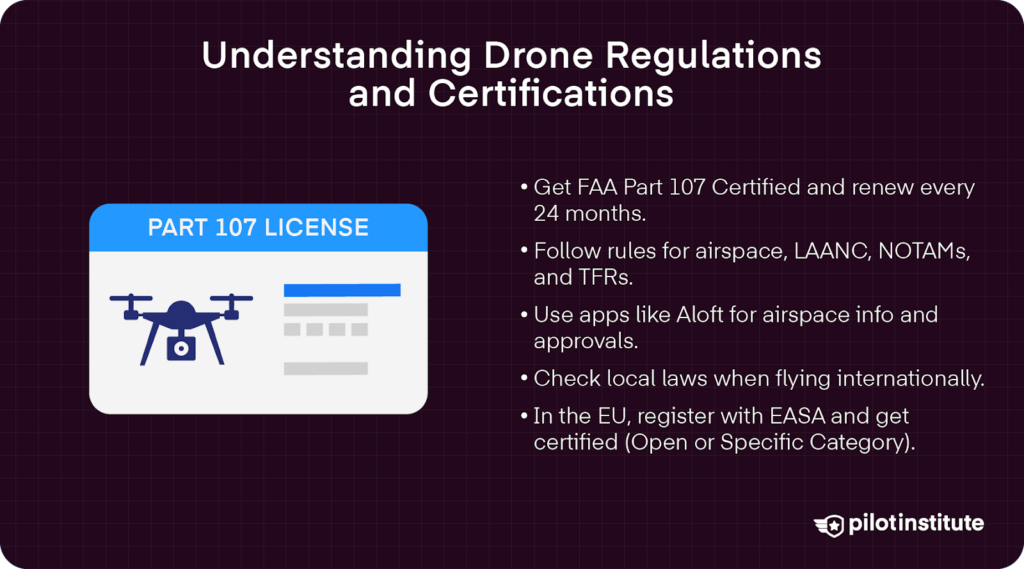
No matter what niche you dive into, it is critical to stay compliant with the FAA’s regulations for commercial operations.
All pilots looking to fly their drones commercially must achieve Part 107 Certification and continue to prove the currency of their aeronautical knowledge by taking recurrent training every 24 months.
Once Part 107 certified, pilots should always adhere to rules related to controlled airspace, LAANC requests, NOTAMs, and temporary flight restrictions (TFRs). Use mobile apps like Aloft for airspace information, restrictions, and LAANC approvals.
When operating in other countries commercially, make sure to check their national aviation authority’s rules. There may be additional certifications, insurance policies, or permissions you need to fly commercially.
In the European Union, for instance, drone pilots must register with the EASA as a drone operator and get certified as a Remote Pilot. Most pilots operating “low-risk commercial activities” would seek certification in the EASA Open Category.
For operations with more risk, such as BVLOS flights, a Specific Category may be needed that requires prior authorization and the creation of a detailed risk assessment form.
Tips for Starting a Successful Drone Business in 2025

Choosing the Right Idea: Research & Development
With so many drone business options, which one is right for you?
You can narrow down your niche by researching local and global demand to analyze market trends. Go where the money is headed!
Any service gaps in your local area also signify a need that you can fill, without facing the threat of steep competition.
Profile existing businesses in a detailed competitor analysis to understand what is working, and how you can differentiate your approach.
Aligning with Your Skills and Interests
Match your personal experience and technical skills with your ultimate business choice. What drives your passion? Look for ways to break into an industry you are truly interested in.
Leverage existing knowledge and networks to facilitate entry into industries you are familiar with. Have experience in post-production? Offer editing services with your videography, surveying, or monitoring packages to make your business a one-stop shop for your customers.
Evaluating Startup Costs and ROI
Check the numbers! Break down equipment and other startup costs compared to average income potential. Don’t forget to include the cost of certifications, insurance, and necessary software.
Estimate potential net profit and set price point expectations by researching existing market rates.
Calculate potential Return on Investment (ROI) to assess long-term financial sustainability. In the planning stages, you can play with ROI calculators to understand how entry costs and potential income play into what you can make.
Investing in the Right Equipment
Once you understand your business needs, match drone features, like camera quality and sensor options, with service requirements.
Consider future scalability by sticking with the most cutting-edge technologies or modular designs that allow you to operate in multiple industry spaces.
Don’t forget insurance! Many job offers for contract work in UAV operations require pilots to not only have a valid Part 107 Certification but also at least $1 million in commercial drone insurance as well.
Developing Marketing and Networking Strategies
Build a brand from the ground up with a polished website and an engaging social media presence.
Or partner with existing companies looking for contractors or full-time drone pilots and repair employees.
Network with other professionals in your niche. You can join professional organizations and drone pilot associations, like AOPA Drone Pilots, which offers members training and safety resources, as well as key networking events to help you build a foundation in a new field.
Embracing Continuous Learning and Innovation
Never stop learning. Keeping up with industry trends and changing regulations empowers you as more competitive.
Conclusion
There are vast opportunities in the growing drone industry. If you’re interested in starting a drone-related business, check out our course Drone Business Made Easy. Now is the time to trust your strengths, get in where you fit in, and grow. The sky truly is the limit!
